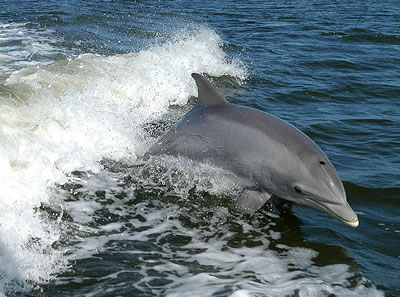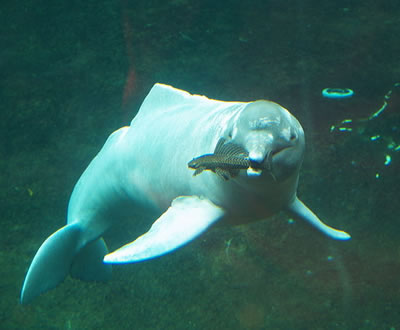Dolphins

Facts about creatures
- Home
- Animal Classification
- Animal Habitats
- Amphibians
- Arthropods
- Bats
- Birds
- Carnivorans
- Cetaceans
- Chordates
- Crustaceans
- Dinosaurs
- Diprotodonts
- Elephants
- Fish
- Golden Mole
- Insects
- Lagomorphs
- Mammals
- Mammal Teeth
- Marsupial Mole
- Metamorphosis
- Mollusks
- Primates
- Reptiles
- Rodents
- Ruminants
- Soricomorphans
- Tenrec
- Tetrapods
- Vertebrates
Dolphins
Dolphin is a word that is used to describe a number of different species of the suborder of cetaceans that is known as Odontoceti. This suborder also includes toothed whales and porpoises.
Generally, people use the word “dolphin” to describe smaller odontocetes that are not porpoises. They use the word “whale” to describe larger cetaceans.Some people say that all odontocetes are toothed whales. Therefore, a dolphin or a porpoise is a kind of whale.

Dolphins are thought to be among the most intelligent animals on Earth. They may posess self-awareness. According to some studies, dolphins can recognize themselves in mirrors. They have been observed using tools and passing their knowledge of tool use onto their young.
Dolphins communicate using whistles, clicks and screeches.
Research has suggested that some dolphins have “names” – whistles that identify individual dolphins. A dolphin may refer to another dolphin by name (by its signature whistle).
In many cultures, dolphins are considered to be lucky.
They are known for riding on bow waves created by ships and boats.
Dolphin Characteristics
Dolphins have the same characteristics as all odontocetes:
- Dolphins have teeth and are carnivorous.
- A dolphin has one blowhole. (Baleen whales have two blowholes.)
- Dolphins use echolocation to navigate and to hunt. Like all odontocetes, dolphins have organs known as melons on their heads. Melons are made up of fatty tissue and are used to focus sound waves. Dolphins have asymmetric skulls and faces. This asymmetry helps with echolocation.
- Dolphins often live in large groups and hunt cooperatively.
A group of dolphins is known as a pod. The size of a pod may range from a few individuals to more than a thousand.
When hunting, dolphins often work together to herd fish. When herding, a pod will surround a school of fish and then squeeze the fish into a small circle. From time to time, a few dolphins will dash through the circle and eat some of the fish.
Dolphins are usually black, gray or brown on top with lighter-colored undersides.
Many species of dolphin have elongated jaws that form a beak.
Dolphin Altruism
Dolphins have a reputation for being altruistic.
They are well-known for their tendency to support animals that are ill or injured.
Dolphins will position themselves underneath another ill or injured dolphin and hold it up to the water’s surface so that it can breathe.
They may circle an ill or injured dolphin and act aggressively toward any potential threats, such as boats that come too close. Dolphins have been known to bite harpoon lines.
Dolphins will behave in the same protective manner toward other kinds of ill or injured marine mammals and toward humans that are in distress.
There are reports of dolphins rescuing human swimmers who were drowning and of dolphins protecting humans from sharks.
There are two main kinds of dolphins: oceanic dolphins and river dolphins.
Oceanic Dolphins
Oceanic dolphins, also known as marine dolphins, are cetaceans that belong to the family Delphinidae.
They can be found in oceans all over world, usually in the shallow waters above continental shelves.
The family Delphinidae is part of the superfamily Delphinoidea, which also include porpoises, the beluga whale (Delphinapterus leucas) and the narwhal (Monodon monoceros).
Oceanic dolphins are more closely related to porpoises, belugas and narwhals than they are to river dolphins.
Some of the Delphinidae are commonly called whales. These are:
- the killer whale (Orcinus orca), or orca
- the false killer whale (Pseudorca crassidens)
- the pygmy killer whale (Feresa attenuata)
- the melon-headed whale (Peponocephala electra),
- the long-finned pilot whale (Globicephala melas)
- the short-finned pilot whale (Globicephala macrorhynchus).
All of these “whales” are really dolphins.
Most, but not all, species of oceanic dolphins have dorsal fins. A dorsal fin is a fin on the dolphin’s back.
Oceanic dolphins usually eat fish, small crustaceans and squid.
Killer whales will also eat sea birds and other marine mammals, such as sea lions, seals, whales, porpoises and other dolphins.
The killer whale is the largest of the dolphins. Killer whales usually range from about 16 to 30 feet long and can weigh from 1 1/2 to 7 tons.
River Dolphins
Update 27 Jan 2014
In January 2014, an article in the scientific journal PLOS ONE announced the identification of a new species of river dolphin in the Araguaia-Tocantins river basin in Brazil. The newly identified species, the Araguaian river dolphin (Inia araguaiaensis) diverged from the Amazon river dolphin (Inia geoffrensis), about 2 million years ago, when the Araguaia-Tocantins basin and the Amazon basin separated. This is the first disovery of a new river dolphin species in almost 100 years.
Read the full research article: A New Species of River Dolphin from Brazil or: How Little Do We Know Our Biodiversity.

River dolphins are dolphins that live in rivers and estuaries.
The living species of river dolphin are:
The La Plata dolphin (Pontoporia blainvillei), also known as the Franciscana
The Amazon river dolphin (Inia geoffrensis), also known as the pink river dolphin, boto, bouto or bufeo.The Bolivian river dolphin(Inia geoffrensis boliviensis) is sometimes considered a subspecies of the Amazon River dolphin and sometimes considered a separate species (Inia boliviensis).
The Ganges and Indus River dolphin, (Platanista gangetica), also known as the blind dolphin or the side-swimming dolphin.
The Ganges and Indus river dolphin is divided into two subspecies, the Ganges river dolphin (Platanista gangetica gangetica), also known as the susu, and the Indus river dolphin (Platanista gangetica minor), also known as the bhulan. The Ganges and Indus river dolphins were once thought to be two distinct species.
The Araguaian river dolphin (Inia araguaiaensis),whose discovery was reported in 2014.
The Chinese river dolphin (Lipotes vexillifer), also known as the Yangtze river dolphin, or baiji, is believed to be extinct.
The other river dolphin species are in danger of extinction.
All of the river dolphins, except for the La Plata dolphin, live in freshwater rivers.
The La Plata dolphin is a saltwater dolphin. It lives in the La Plata River (Río de la Plata) estuary in South America and along South America’s Atlantic Coast.
A river dolphins will eat fish and crustaceans.
River dolphins have snouts that are thinner and much longer than the snouts of oceanic dolphins. They can use their long snouts to grab fish or crustaceans in the mud at the bottom of rivers and estuaries and to catch fish swimming between the roots of trees on river banks.
Unlike many other cetaceans, they can turn their heads from side to side. This allows them to be more flexible when they swim in shallow waters and when they swim between tree roots.
A river dolphin will swim between tree branches if the river floods so that the branches are underwater.
The Ganges and Indus river dolphin may swim on its side, so that one flipper is trailing along in the mud. Swimming this way may help these dolphins to catch fish in the mud.
River dolphins have small eyes and poor vision. Acute vision is not much help to animals that must navigate and hunt in muddy waters.
The Ganges and Indus River dolphins have no eyes and are effectively blind. They may be able to distinguish between light and dark.
To compensate for their inability to see well, river dolphins have more acute echolocation abilities than other cetaceans.
River dolphins are usually gray or gray-brown, with lighter-colored undersides.
The Amazon river dolphin is born gray and turns pink as it gets older. Amazon river dolphins will turn bright pink when they are excited.
The Ganges and Indus river dolphin and the Amazon river dolphin do not have dorsal fins. They have humps on their backs instead of dorsal fins.
The La Plata dolphin has a dorsal fin and the Chinese river dolphin had a dorsal fin.